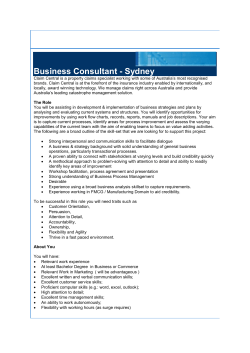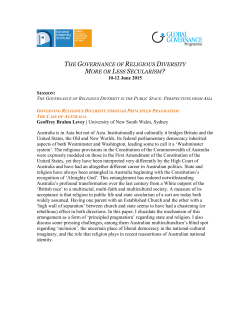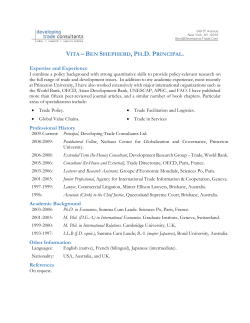
a copy of Erwin`s slides
The Climate Institute What should Australia’s target be? Australia's post-2020 emissions target March 2015, ANU Crawford School, Erwin Jackson, Deputy 1CEO The Climate Institute The Climate Institute has been tracking international climate change negotiations since 2005 + Staff have expertise in international processes dating back to before the development of the UNFCCC + Strong international network with other think tanks, NGOs and government advisors + Play an ongoing role in publishing papers, and commentary of what matters internationally (and what does not) 2 International context + Avoiding 2oC key benchmark for action + Binding to commit with international review + Cycle of growing ambition: No backsliding and ongoing process to increase ambition (“progression”) + Supported by binding domestic policies + Opportunity for Australia to define emission pathway consistent with national interest in avoiding 2oC 3 Top down pressure – bottom up action 2oC, progression, and not just special pleading TODAY NET ZERO Domestic actions build ambition, trust and confidence 4 Progression towards 2oC Annual change in emissions 1.0% 0.0% -1.0% -2.0% -3.0% -4.0% -5.0% -6.0% -7.0% 2010-2020 2021-2025 5 Key considerations Consideration Implications Vulnerability to climate change + Participation and ambition matter + Below 2oC in national interest Top-down expectations + bottom up contributions + Norms created by national contributions + Below 2oC needs to be norm not exception Economic costs and benefits + Not determined by national target + Domestic policy design influenced by trade and the actions of other countries Decarbonisation inevitable + Climate, political, technological trends heading (too slowly) in one direction + Credible signal for decarbonisation the only way to create policy stability 6 Conclusions Discussion of national targets an opportunity to focus on the national interest and strategic policy objectives. Targets defined by the national interest in limiting warming to less than 2oC can: + Support international norms consistent with participation and ambition + Balance short term action with strategic goals + Provide greater policy stability by reinforcing the inevitable 7 More information www.climateinstitute.org.au @climateinstitut www.facebook.com/theclimateinstitute 8 Australia’s new post-2020 targets Overall carbon budget: around 8 billion tonnes CO2-e 9 Back up slide –GDP and emissions Source: TCI calculations based on ABARE 2006; Allens Consulting 2006; The Climate Institute 2007; Treasury 2008, 2011; Climate Change Authority 2014; ClimateWorks, ANU, CSIRO 2014 10
© Copyright 2025










